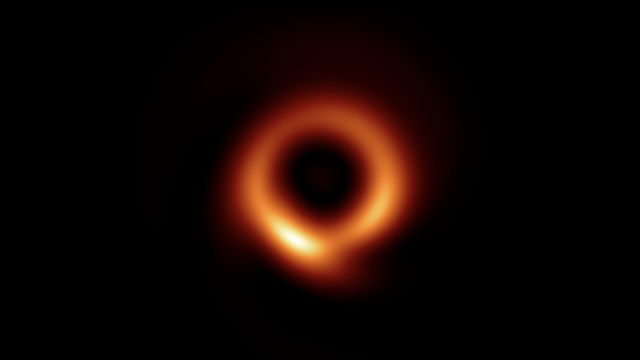Using machine learning, a team of researchers has enhanced the first image ever taken of a distant black hole. Importantly, the newly updated image shows the full resolution of the telescope array for the very first time.
Black holes are some of the most massive objects in the universe. Their gravitational pull is so intense that light cannot escape their event horizons, hence the blackness at the centre of the above image. You’re not actually seeing the black hole, but rather the superheated material surrounding it that creates a silhouette of where the object resides.
The machine learning model has sharpened the otherwise blurry image of black hole M87, showcasing the utility of machine learning models in improving radio telescope images. The team’s research was published today in the Astrophysical Journal Letters.
“Approximately four years after the first horizon-scale image of a black hole was unveiled by EHT in 2019, we have marked another milestone, producing an image that utilises the full resolution of the array for the first time,” said Dimitrios Psaltis, a researcher at Georgia Tech and a member of the EHT collaboration, in an Institute for Advanced Study release. “The new machine learning techniques that we have developed provide a golden opportunity for our collective work to understand black hole physics.”
Back in 2019, scientists with the Event Horizon Telescope released the first-ever image of a black hole: M87, a supermassive black hole 55 million light-years away. The 6.5-billion-solar-mass object was imaged using a network of seven telescopes on four different continents, to create a massive radio telescope array.
But even using radio telescopes around the world doesn’t give astronomers a complete view of the black hole; by incorporating a machine learning technique called PRIMO, the collaboration was able to improve the array’s resolution. What appeared a bulbous, orange doughnut in a 2019 image has now taken on the delicate, thin circle of The One Ring.
PRIMO (principal-component interferometric modelling) was used to study over 30,000 simulated images of black holes in the process of accreting gas. It’s the accretion of such superheated material that gives imaged black holes their eerie silhouettes. The patterns in the simulations were then used to boost the resolution of the fuzzy image released in 2019.
“We are using physics to fill in regions of missing data in a way that has never been done before by using machine learning,” said Lia Medeiros, a researcher at the Institute for Advanced Study and the lead author of the paper, in an institute release. “This could have important implications for interferometry, which plays a role in fields from exo-planets to medicine.”
Sharper images of black holes can help physicists hone in on details of the objects, like the true areas of their event horizons and the gravitational forces the objects exert. For example, the new image of M87 scaled down the luminous ring around the black hole by a factor of two.
Last year, the EHT released an image of another black hole: Sagittarius A*, the black hole at the centre of our galaxy. That shot was similarly fuzzy to the first look at M87; if applying machine learning to black hole images becomes routine, we may see a sharper view of the centre of our galaxy soon.
